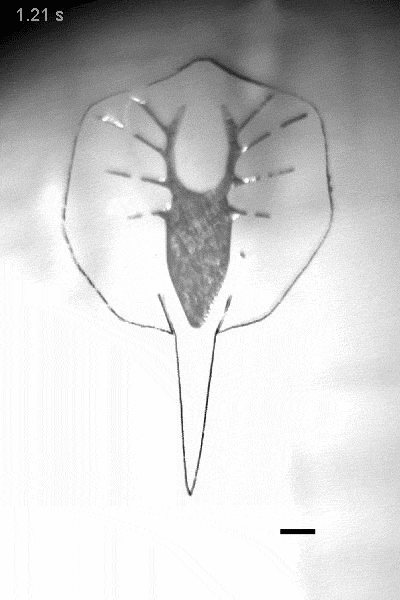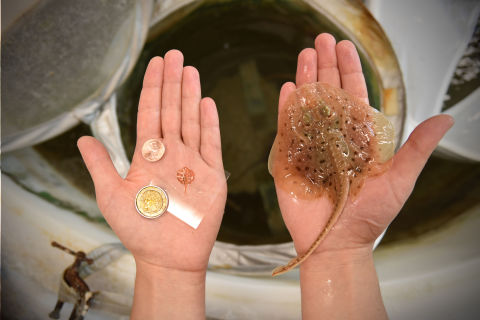This soft robotic stingray is made of rat heart muscle. Yeah, it's just as crazy as it sounds.
"Roughly speaking, we made this thing with a pinch of rat cardiac cells, a pinch of breast implant, and a pinch of gold. That pretty much sums it up, except for the genetic engineering," says Kit Parker, the bio-engineer at Harvard who led the team that developed the strange robot.
"I THINK WE'VE GOT A BIOLOGICAL LIFE-FORM HERE."
Parker's robotic stingray is tiny—a bit more than half an inch long—and weighs only 10 grams. But it glides through liquid with the very same undulating motion used by fish like real stingrays and skates. The robot is powered by the contraction of 200,000 genetically engineered rat heart-muscle cells grown on the underside of the bot. Even stranger, Parker's team developed the robot to follow bright pulses of light, allowing it to smoothly twist and turn through an obstacle courses. The fascinating robot was unveiled today in the journal Science.
"By using living cells they were able to build this robot in a way that you just couldn't replicate with any other material," says Adam Feinberg, a roboticist at Carnegie Mellon University who has worked with Parker's team before, but was not involved in developing this new robot. "You shine a light, and it triggers the muscles to swim. You couldn't replicate this movement with on-board electronics and actuators while keeping it lightweight and maneuverable. And it really is remote controlled, like a TV set."
HOW TO BUILD A LIVING BOT
To understand just how muscles from a rat can power a robot stingray, let's dissect this bad boy layer by layer. The stingray bot is composed of four sequential layers of material. The top layer is a 3D body of a silicone material—"the same thing as the outer coating of a breast implant," says Parker—that's been cast in a titanium mold. This flexible, bendy body holds the other materials together.
The second layer down is a simple gold skeleton. "The skeleton's there because we needed some recoil, so that the pectoral fins bounce back to their original positions" once they're done undulating, Parker says. Why gold? The team found the material had just the right stiffness and flexibility to bend and bounce, "and it's really easy to work with," he says.
The third layer down is another hyper-thin layer of silicone. This prevents the heart muscle from having direct contact with the gold, but also plays another huge role. Along with that top 3D layer, the silicone is cast with just the right small-scale patterns so that the next layer, the rat cells, "grow with the exact muscular architecture we want," says Parker. "With the right geometric design, we can guide these cells to form the tissue we want."
Lastly, the underside of the robot is layered with living rat cells. These cells have been genetically engineered, and are originally from the heart muscles. Parker layers them on each of the robot stingray's two fins in a serpentine, back-and-forth pattern. These cells send along a signal for other cells down the line, creating a switchback cascade of flexing muscle that pulls the fins in the exact undulating motion of a real stingray.
Here's where the genetic engineering fits in. The robo-stingray's muscles will start to contract only when flashed by a specific wavelength of bright light. This is done through a genetic engineering technique called optogenetics, which allows otherwise normal cells to respond to light. To guide his stingray, Parker merely has it follow a flashing, two-pronged light source. When the lights flash, the bot starts undulating. To have the stingray bank and turn, Parker need only flash one side of the stingray with a brighter, or more rapidly flashing light. Both will cause fins to stroke faster or more powerfully.
The bot can swim in a liquid that has suspended nutrients in it to keep the rat heart cells fed and alive. Even after 6 weeks, the stingray bot was still swimming with over 80 percent of its cells still alive and well. "But there are definitely challenges that need to be overcome," says Feinberg. Even with the right nutrients you wouldn't be able to swim this bot outside of a lab, because the cells are basically defenseless to infection. "They don't have an immune system, so it's not protected from bacteria or fungus," Feinberg says.
"WE MADE THIS THING WITH A PINCH OF RAT CARDIAC CELLS, A PINCH OF BREAST IMPLANT, AND A PINCH OF





0 التعليقات:
إرسال تعليق